In This Guide:
- Working with Vinyl Siding
- Preparation and Planning
- Buy the Right Amount of Siding
- Step-by-Step Installation Instructions
- Cutting Vinyl Siding
- Complete Video Guide (33 Minutes)
- What to Read Next
- Over to You
Installing siding of any kind is a big investment in your home so it’s important that the installation be done properly to ensure that it is watertight, looks great and will stand the test of time.
Vinyl siding is one of the most durable and affordable ways a homeowner can protect their property from storms, moisture, and insects. One way to save money on the installation of siding is to avoid some labor costs by doing some of the removal and installation yourself.
With this guide, a few tools, and some DIY experience and confidence, you can remove and install vinyl siding yourself.
Working with Vinyl Siding

Installing any kind of siding involves a lot of time and effort, and there are many details that must not be overlooked. However, vinyl is much easier to remove, modify and install than any other type of siding, so don’t let it deter you if you want to add a new window, move a door or build an addition.
Here, we’ll describe how to rework vinyl siding around a new window. This will give you the basics for an entire job, and cover the finish areas as well. For in-depth instructions and advice specific to the style and type you’re working with, ask the manufacturer or retailer for a copy of their complete installation manual.
In this guide we’ll discuss:
- Removing old/damaged vinyl
- Installing new parts
- Measuring, cutting, fitting and nailing
- Making the installation watertight
Preparation and Planning
Besides the tools listed below, you may also need a snap-lock punch if you plan to install siding in new areas, such as on an addition or a boarded-in space where the old window resided. The zip (unlocking) tool is a specialized tool that is needed for reworking areas.
You will also need new trim pieces, because those usually break when they are removed, and are not reusable. For this example, we’ll need J-channel for around the new windows as well as undersill trim.
Tools & Equipment Required
- Space to work: a staging area for the strips of vinyl as they are measured and cut
- Work table
- Carpenter’s square
- Power saw (either hand or radial arm)
- Abrasive wheel for power saw (or a plywood cutting blade)
- Carpenter’s tape measure
- 2ft to 3ft level
- Plumb bob
- Stepladder
- Chalk line
- Claw hammer
- Tinner’s snips
- Pry bar
- Zip tool
- Utility knife
Materials Required
- Siding
- Building paper (for a moisture barrier)
- Housewrap tape
- Aluminum Flashing
- J-channel
- Undersill
Buy the Right Amount of Siding

Don’t scrimp on this part. It’s always better to have a few linear feet of siding left over than to run out before you finish the job. Besides, you want enough to make repairs if necessary.
Using a measuring tape from the ground or a ladder, do your best to get measurements of each section that will have siding installed.
To calculate the area, simply multiply the height by the width of each rectangular section in feet. This gives you the area in square feet.
Measure/approximate the width and height of gables and other triangular sections by measuring at the highest and widest points. Multiply the height by the width and divide that number by 2 to get the area of the triangle.
Don’t subtract any square footage for doors and windows. You may need this extra to get the perfect fit for your siding. Once you have all your measurements, add them together for the total square feet.
Now that you have the total square feet, divide by 100. That number is how many squares of siding you will need. One square = 100 square feet.

Step-by-Step Installation Instructions
Here you’ll learn how to remove the existing siding, apply the moisture barrier and window flashing, install a J-channel, and lastly secure the siding.
1. Remove the Siding
a) Unlock siding using a zip tool

Mark the strip of vinyl you want to remove. Then, slide the zip tool under the butt edge of the strip ABOVE the one you want to remove. You’ll hook the edge that is locked to the lower, damaged strip. Slide the tool to the side, and it will unzip the seam.
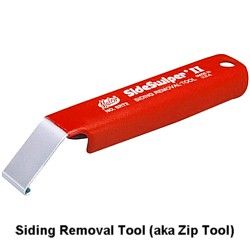
Unzipping the vinyl may be difficult if it is old, because it may have become quite brittle. If you can’t get the zip tool into the preferred spot, try moving up one course. Don’t be horrified if the siding unzips without a tool. With newer siding, you can often just use your hands.
Once you unzip the two pieces, you can lift the upper, undamaged strip and see the nail strip to the damaged vinyl.
Be sure to mark the top of the course so you know where to place the replacement vinyl. This helps with level, too. Then, you are ready to start pulling nails.
b) Pull out the nails

The nails have not been driven in tightly if the previous installation was done correctly. It’s important to leave a little “wiggle room” so the vinyl strips can expand and contract with temperature fluctuations.
Since the nails are not flush with the wall it will be easier to fit a pry bar beneath them to pull them out. It is important, at this point, to remember to keep the pry bar or claw hammer off of the siding. Otherwise, you may break the strip.
Now that you have the nails removed, it is time to lower the strip of siding. Be sure to number it so that you know where it came from and where it should go. Lower the strip so that it releases the vinyl below it. If the end of the strip is tucked into trim, bow it to pull it out. Right around the window, you may have to move shorter pieces up and down to get them to release from the J-channel.
Continue in this manner until you have removed enough siding to replace the window.
c) Matching Your siding
It is important to save all of the siding you remove. You may need to reuse it. The trim pieces can be replaced, and are hard to remove without damaging them. Take a section of siding to your home improvement center and see if they can match it with new siding.
Vinyl siding will fade as it ages. Professionals will often remove faded siding from a less conspicuous section of the house, and use it on more visible window sections. You can put the new siding on the less visible spot. In some cases, you may need to put replace an entire wall with new vinyl.
d) Surface preparation
Check all wood trim and replace any boards that are damaged or rotted. Make sure all loose boards are nailed into place.
Thoroughly scrape all of the old caulk off of the doors and windows. This old caulk can get in the way when you are trying to position the new trim.
Go ahead and take down any attachments to the outside of the area you are working on. Downspouts, moldings, lights, or decorations will interfere with your work. They need to be reinstalled on top of the new siding, anyway, to make them watertight.
You may want to cut off any window sill extension. This will allow you to install new trim, flush with the casing.
Protect landscaping. Any shrubbery should be tied out of the way.
Cutting Vinyl Siding

As mentioned before, vinyl siding is designed to be installed loosely, so it can respond to temperature variations without damage. You want to keep the individual panels from buckling. To do that, fit it in this way:
There should be a ¼ inch gap at each end. The trim pieces will cover the gap. It is crucial that the panels are able to expand and contract behind the trim without being inhibited.
You will lock the panel into the panel below it. Pull it up snugly, without creating a great deal of torque. Nail it into place.
There are slots for the nails. Center a nail in a slot and drive it in, leaving a little “wiggle room” for the panel. The shank of the nail should be exposed by about 1/16 of an inch.
2. Building Paper (Moisture Barrier) and Window Flashing
Proper installation of the building paper and flashing are crucial to protecting your investment. It serves as a moisture barrier that keeps any moisture that gets past the siding from saturating the walls of your home.
The flashing is crucial for creating a watertight seal around windows and doors. With vinyl siding, aluminum is the best material for flashing. It usually comes in 10-inch-wide rolls that can be cut into 5-inch-wide strips with the tinner’s snips. This will be used at the top and sides of your window.
a) Install the building paper
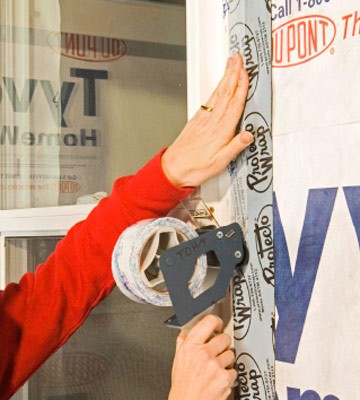
Starting at the bottom of the wall, install the building paper. Overlap the next piece over the lower piece as you move up the wall. If there are any tears in the paper, tape over them with housewrap tape. Tape the overlap, too.
b) Install the flashing under the window

Place the new window in its opening, and tack it into place. The width of flashing you use beneath the window will be based on the placement of your vinyl strips. It should be wide enough to slip under the bottom edge of the fin and overlap the nail strip of the siding below it. When installed this way, any moisture will be redirected to the front of the siding.
c) Install flashing next to the window
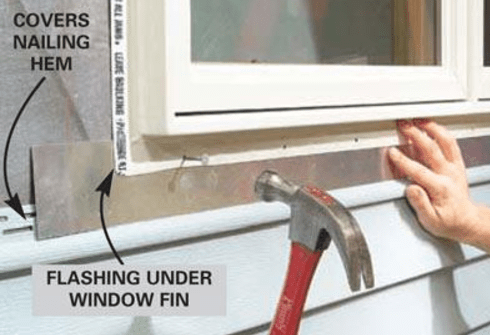
Cut 5-inch strips of flashing that are 2 inches taller than the window and will overlap the bottom flashing by 2 inches. Install the flashing from the bottom up.
The 5-inch-wide flashing should slide right under the nailing fin on the window. Secure it.
d) Place flashing over the window

Once you have the bottom and side flashing installed around the window, cut a slit in the building paper 2 inches above the window.
Remember, at this point, you still don’t have flashing above it.
Now you will take a 5-inch strip of flashing and slide it up under the slit above the window. The bottom of the flashing should overlap the side strips of flashing and the nailing fin. Secure the flashing.
Here is where you step back and study your work. Imagine water running down the side of your house. The building paper and siding should overlap top to bottom, so that any water will slide down the side, rather than building up in seams of paper or flashing.
3. Install J-channel Around the Window
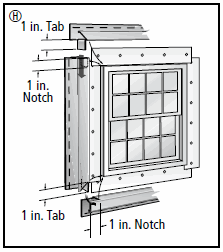
The next step in waterproofing your window is to install the J-channel. This goes all around the window, and you’ll need new strips. You work from the bottom up with this step as well, overlapping top to bottom.
It will look much better if you miter the corners. This gives it a clean, professional look. Be sure that the top channel fits correctly over the side pieces, because this area will channel a lot of water.
a) Notch the J-channel
You will cut a strip of J-channel that is 2 inches longer than the window is wide. Mark a spot 1 inch from each end, and use your utility knife to score the J-channel on those lines.
b) Finish the notches with tin snips
You’ll make the last 2 cuts with your tinner’s snips. To get the tab off, bend it forward and back until it snaps.
c) Install J-channel underneath
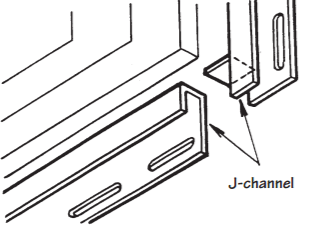
Hold the J-channel beneath the window, then cut and position the undersill trim if you are using it. (Check the section “When to Install Undersill Trim.”) You’ll now drive roofing nails into the slots, spacing them about 8 to 10 inches apart. As with the siding, don’t drive the nails in flush. The trim pieces need to slide back and forth a little bit.
d) Cut J-channel for the sides

The sides piece of J-channel should also be 2 inches longer than you actually need, based on the height of the window. You’ll make the same miter on the bottom. You’ll also cut that 1-inch notch on the top end. Be sure to lap the side piece over the bottom, then secure it with roofing nails the way you did the bottom.
e) Side J-channel detail
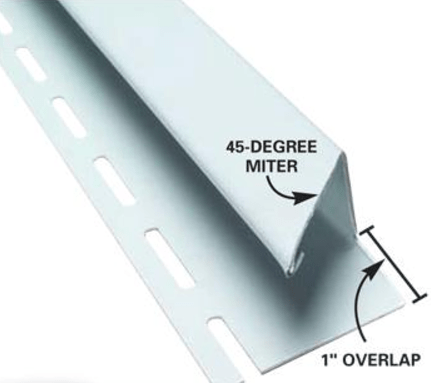
Cut 45-degree in the side J-channel.
f) Cut J-channel for the top

This piece will be 2 inches wider than the window. Cut both ends and bend them, lapping them over the side pieces. Nail it into place.
g) Top J-channel detail
To finish the J-channel, cut and notch the top piece to fit above the window.
4. When to Use Utility (Undersill) Trim
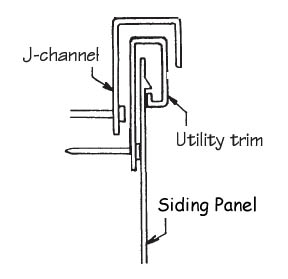
The siding is beveled, and the cut edge beneath a window may end up gapping as much as a half inch. If this edge is within ¼ inch of the edge, an undersill trim will lock it down. If it is over ¼ inch from the cut edge, just use the J-channel.
5. Install the Siding
This is where it can get a little tricky, because it can be hard to maneuver those long strips of vinyl into place. Start at the bottom of the wall and work your way up.
Start with fitting the end under the trim. Then, bow the strip of siding and place the other end under the trim. One the ends are tucked in, slide the strip upward and snap it into the locking edge of the plank below it.
Around the window you will feed the shorter sections at the sides into the channel located at the top. Slide each piece down and snap it into place.
In our example, we needed to remove one more course above the window. We ended up cutting the piece and placing a joint above the window, and then completed the row with a longer length of vinyl. Overlap all of the butt joints by 1 inch and do not caulk the joints. If you have to use new vinyl, the colors won’t match.
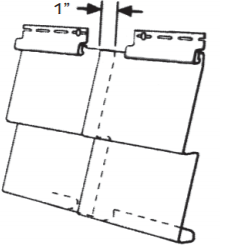
a) Mark the cuts for siding under the window
Place the siding that has to be notched under the window. When you mark each side, add a ¼ inch to the width to allow for expansion. To get the depth of the notch, measure the distance from the locking tab on the siding below to the undersill trim.
b) Cut the siding to fit under windows
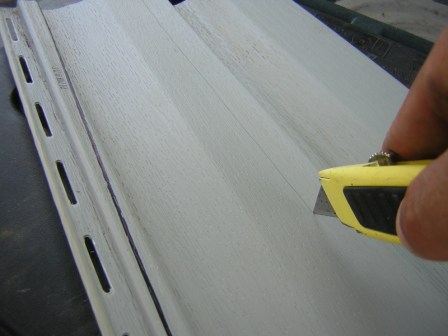
Use the snips to cut through the nailing hem. Then, use the utility knife to score the plank, and bend it to snap off the notch.
c) Install the notched siding
Place the notch under the window and slide it into the undersill trim. Push the butt edge against the locking edge on the plank below and snap it into place. Verify that the top edge of the plank you have just installed follows the layout line, then nail it into place.
d) Don’t nail the siding tight against the wall

Once again, be careful to leave wiggle room for the siding. Leave about 1/16 to 1/8 so the siding can expand and contract.
e) Install siding over the window
You may need to center a butt joint over the window in order to get these last pieces installed. Measure the top piece, and notch it. Lock the plank into the lower one, and nail it down.
f) Lock the siding together
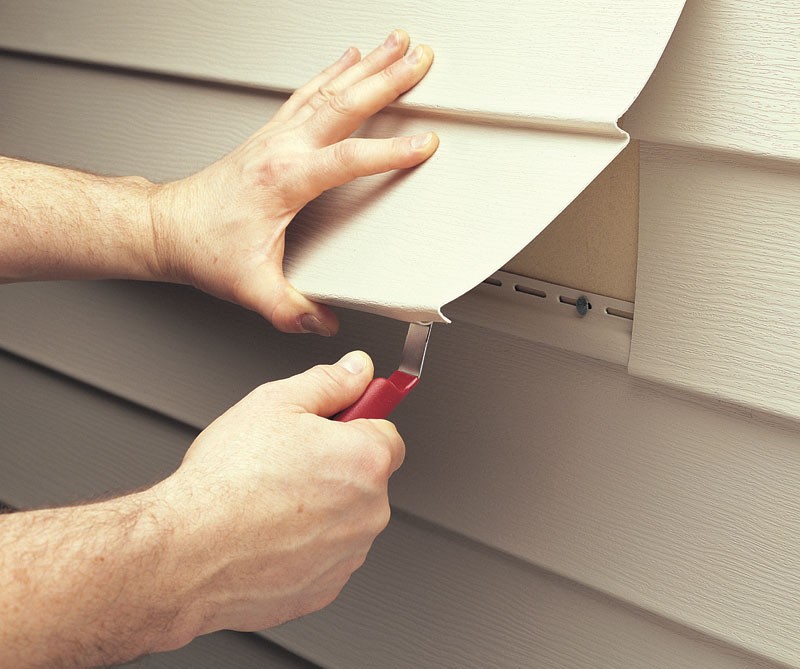
For the last step, use the zip tool to pull the last loose edge down over the locking edge. You will probably have to push the against the wall and pull it down to get it to lock. Then slide the zip tool down the length of the plank.
Complete Video Guide (33 Minutes)
What to Read Next
8 Styles of Vinyl Siding to Choose From
Best Vinyl Siding Products & Brands
Cost to Install Vinyl Siding
Over to You
We’re interested to know – have you installed siding yourself or did you have a contractor do it? What challenges (if any) did you run into? Let us know by leaving a comment below!

i have installed the siding by myself excellent tutorial thanks it worked out great